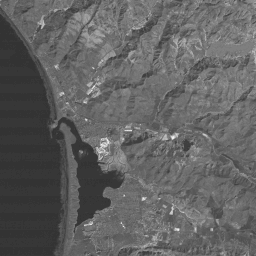Ratioing¶
Ratioing is an enhancement process in which the DN value of one band is divided by that of any other band in the sensor array. If both values are similar, the resulting quotient is a number close to 1. If the numerator number is low and denominator high, the quotient approaches zero. If this is reversed (high numerator; low denominator) the number is well above 1. These new numbers can be stretched or expanded to produce images with considerable contrast variation in a black and white rendition. Certain features or materials can produce distinctive gray tones in certain ratios; TM Band 3 (red) divided by Band 1 tends to emphasize red- or orange-colored features or materials, such as natural hydrated iron oxide, as light tones. Three band ratio images can be combined as color composites which highlight certain features in distinctive colors. Ratio images also reduce or eliminate the effects of shadowing.
Ratioing¶
Three pairs of ratio images can be co-registered (aligned) and projected as color composites. In individual ratio images and in these composites, certain ground features tend to be highlighted, based on unusual or anomalous ratio values. For example, an ore deposit may be weathered or altered so that a diagnostic surface staining, called gossan, develops. This stain consists of hydrated iron oxide (rust) that is normally yellow-brown. In Band 3, this material reflects strongly in the red but it is apt to be dark in Band 4. The ratio quotient values for this situation tend, therefore, to exceed 2-3, giving rise to a bright spot pattern in a 3/4 image.
` <>`__1-18: Although this is a rare natural situation, rocks containing native copper could develop a distinct greenish tone (think on occasions where you saw weathered copper roofing or a penny that had been outdoors a long time). What two TM bands might you ratio to distinguish this surface indicator of copper from natural vegetation. `ANSWER <Sect1_zanswer.html#1-18>`__
IDRISI generates ratio images through a module called OVERLAY. These may need to be rescaled and converted to byte format for display. However, the new images are difficult to combine in composites. We show just one ratio image made by dividing Band 1 DN values into Band 4 DNs, to illustrate a characteristic product.
Most of the image is moderately dark without much variation in gray levels. This implies similarities in DN values for equivalent pixels in the two bands. However, the tonally bright (high DNs) golf course fairways at (**s**) contrast sharply with their surroundings. Fields also stand out in this way. The grassy area at (**v**) has well-defined boundaries and is ligher toned.
` <>`__1-19: Which Principal Component image does this ratio image most resemble? `ANSWER <Sect1_zanswer.html#1-19>`__
(Note: the above ratio images were produced on a DOS version of IDRISI. The writer (NMS) tried to create new ratio images on IDRISIW, the Windows version, with no luck. But excellent examples of DOS version ratios, and ratio color composites, developed earlier, are shown on page 5-3.) To preview this, look at the Band 3/Band 1 ratio image of a mineralized area in southwestern Utah, and then a color composite made from 1/7 = blue; 4/2 = green; 3/1 = red.
The lightest tones coincide with iron enriched surface material (reds and yellows in the field).
The yellows and reds in this composite denote areas of rock alteration and mineralization.
